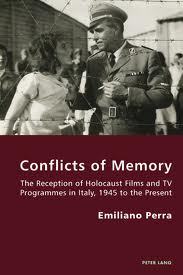
With this book published as volume 8 of the Italian Modernities series, edited by Pierpaolo Antonello and Robert Gordon, the reader is presented with a systematic survey of how Italian cinema and television coped with issue of the Holocaust, since the early post-war years up until today. This study by Emiliano Perra, Lecturer at the University of Winchester (UK), enriches our knowledge especially for what concerns the role played by the TV, which – unlike the film industry - had not previously been investigated.
The book does not consist solely in the presentation and analysis of films and TV programs concerning the Holocaust; the author also attempts to offer an analysis of the reception of such cultural products by analyzing commentaries, debates and reviews on various newspapers and journals. Thus the book proceeds on two distinct and yet intertwined planes. 1) The presentation of 69 films and 46 television programs related to the Holocaust and its representation. Each one is a source that is place into its cultural context and is object of analysis, the depth of which varies greatly according to the level of importance attributed to the single product. 2) The reconstruction, of the wider rhetorical context concerning the various films and TV broadcasts selected, thus offering important elements to understand how those products were received, and how the influenced collective memory.
The author makes a clear statement concerning the major theme that influenced Italian memory politics, determining the construction of cultural frameworks that affected both the production and reception of audiovisual artifacts concerned with the representation of racial persecutions, Fascism, Nazism and the Holocaust. The key paradigm, that changed shape over time transforming and adapting itself to the changing contexts, was that of the «myth of the good Italian». Italians represented themselves as guiltless, and free of any real responsibility concerning the origins, development and implementation of Mussolini’s anti-Semitic campaign, which after 1943 lead to the deportation of about 9000 Italian Jews. The stories Italians narrated, the way they represented themselves through the screens of the cinema or the TV were stories of innocence and victimhood. This is not at all surprising, and is fully consistent with the findings of other studies conducted on Italian memory politics, nonetheless is interesting and important to finally have a documented and convincing overall reconstruction of how such cultural practices were adapted both to the big and to the small screens.
While highlighting and presenting in a convincing manner this element of continuity through the decades, the author does not renounce to offer – at the same time – a reconstruction of the different phases of Holocaust representation in Italy. The book is in fact subdivided into eight chapters; aside from the first one, serving as an introduction, and the seventh - dedicated to the specific theme of the debates concerning the role of the Vatican – the analysis moves from a chapter to the next following a clear chronological order.
Following the evolution of the productions and the debates from the immediate post-war up to the present this research shows how a turning point is represented by the 1980s. Only in that decade did a specific discourse on the Holocaust developed in film industry and in national television; before that moment the Holocaust or Holocaust-related stories were usually an occasion to present other, more pressing or more enticing themes, such as the anti-fascist struggle, or the role of the Church in caring for the oppressed populace. In the 1980s, with the shifting of the international climate and the emergence of an autonomous Jewish discourse on the Holocaust, Italian film industry and TV productions started considering the tragedy of the Jews by itself, awarding it growing attention.
That was when the memory boom started, reaching its peak in the Italian context at the end of the 1990s, with the production of Roberto Benigni’s «La vita è bella» and the airing on national public television of Spielberg’s «Schindler’s List». In those two final decades of the century the Holocaust acquired a central role in Italian collective memory, just as the earlier anti-fascist narrative was visibly declining. Reflecting on this issue, which connects memory and the dramatic transformation of the Italian political scenario (with the emergence of Berlusconi allied with the neo-fascists who underwent a meaningful but non linear revision of their relationship to the fascist experience) the author concludes his book: he dedicates in fact a final chapter to the depiction of what he tentatively qualifies as a «post-antifascist memory».
This is a thorough, convincing and intelligently written work. Although the findings are not, for the most part, particularly original it represents a positive contribution both to the field of Italian memory studies and to the wider field of Holocaust studies.